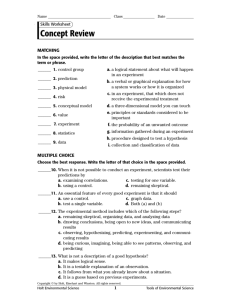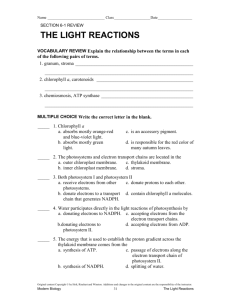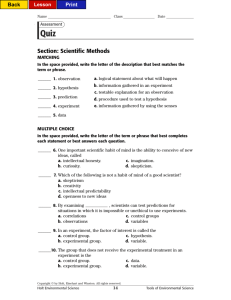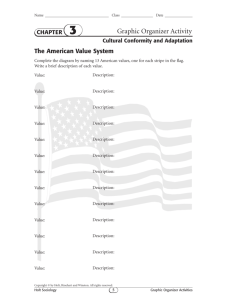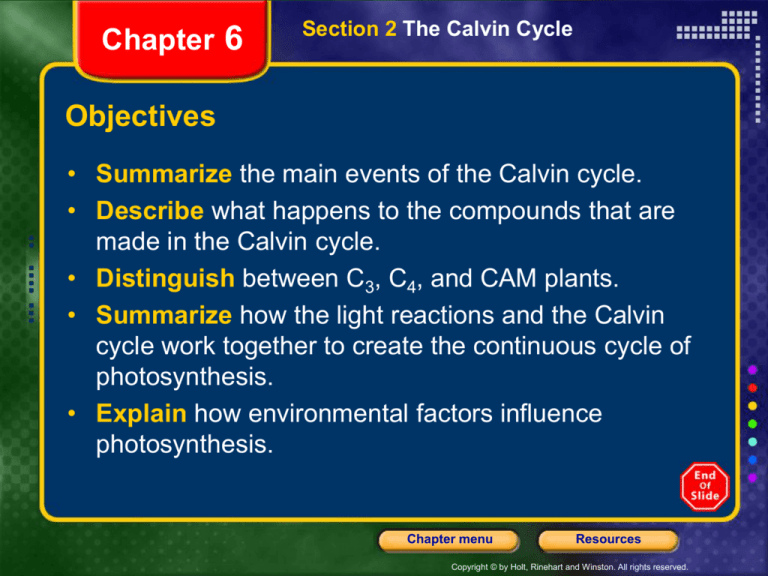
Chapter 6
Section 2 The Calvin Cycle
Objectives
• Summarize the main events of the Calvin cycle.
• Describe what happens to the compounds that are
made in the Calvin cycle.
• Distinguish between C3, C4, and CAM plants.
• Summarize how the light reactions and the Calvin
cycle work together to create the continuous cycle of
photosynthesis.
• Explain how environmental factors influence
photosynthesis.
Chapter menu
Resources
Copyright © by Holt, Rinehart and Winston. All rights reserved.
Chapter 6
Section 2 The Calvin Cycle
Carbon Fixation
• The ATP and NADPH produced in the light reactions
drive the second stage of photosynthesis, the Calvin
cycle.
• In the Calvin cycle, CO2 is incorporated into organic
compounds, a process called carbon fixation.
Chapter menu
Resources
Copyright © by Holt, Rinehart and Winston. All rights reserved.
Chapter 6
Section 2 The Calvin Cycle
Carbon Fixation, continued
• The Calvin cycle, which occurs in the stroma of the
chloroplast, is a series of enzyme-assisted chemical
reactions that produces a three-carbon sugar.
• Most of the three-carbon sugars (G3P) generated in
the Calvin cycle are converted to a five-carbon sugar
(RuBP) to keep the Calvin cycle operating. But some
of the three-carbon sugars leave the Calvin cycle and
are used to make organic compounds, in which energy
is stored for later use.
Chapter menu
Resources
Copyright © by Holt, Rinehart and Winston. All rights reserved.
Chapter 6
Section 2 The Calvin Cycle
Chapter menu
Resources
Copyright © by Holt, Rinehart and Winston. All rights reserved.
Chapter 6
Section 2 The Calvin Cycle
The Calvin Cycle
Chapter menu
Resources
Copyright © by Holt, Rinehart and Winston. All rights reserved.
Chapter 6
Section 2 The Calvin Cycle
Alternative Pathways
• The C4 Pathway
– Some plants that evolved in hot, dry climates fix
carbon through the C4 pathway. These plants have
their stomata partially closed during the hottest part
of the day.
– Certain cells in these plants have an enzyme that
can fix CO2 into four-carbon compounds even when
the CO2 level is low and the O2 level is high. These
compounds are then transported to other cells,
where the Calvin cycle ensues.
Chapter menu
Resources
Copyright © by Holt, Rinehart and Winston. All rights reserved.
Chapter 6
Section 2 The Calvin Cycle
Alternative Pathways, continued
• The CAM Pathway
– Some other plants that evolved in hot, dry climates
fix carbon through the CAM pathway. These plants
carry out carbon fixation at night and the Calvin
cycle during the day to minimize water loss.
Chapter menu
Resources
Copyright © by Holt, Rinehart and Winston. All rights reserved.
Chapter 6
Section 2 The Calvin Cycle
Chapter menu
Resources
Copyright © by Holt, Rinehart and Winston. All rights reserved.
Chapter 6
Section 2 The Calvin Cycle
Factors That Affect Photosynthesis
• Light Intensity
– The rate of photosynthesis increases as light
intensity increases, because more electrons are
excited in both photosystems.
– However, at some point all of the available electrons
are excited, and the maximum rate of
photosynthesis is reached. The rate then stays level
regardless of further increases in light intensity.
Chapter menu
Resources
Copyright © by Holt, Rinehart and Winston. All rights reserved.
Chapter 6
Section 2 The Calvin Cycle
Factors That Affect Photosynthesis, continued
• Carbon Dioxide Levels
– As with increasing light intensity, increasing levels of
carbon dioxide also stimulate photosynthesis until
the rate levels off.
Chapter menu
Resources
Copyright © by Holt, Rinehart and Winston. All rights reserved.
Chapter 6
Section 2 The Calvin Cycle
Factors That Affect Photosynthesis, continued
• Temperature
– As temperature increases, the rate of
photosynthesis increases to a maximum and then
decreases with further rises in temperature.
– The rate peaks at a certain temperature, at which
many of the enzymes that catalyze the reactions
become ineffective. Also, the stomata begin to
close, limiting water loss and entry of carbon
dioxide.
Chapter menu
Resources
Copyright © by Holt, Rinehart and Winston. All rights reserved.
Chapter 6
Section 2 The Calvin Cycle
Environmental Influences on Photosynthesis
Chapter menu
Resources
Copyright © by Holt, Rinehart and Winston. All rights reserved.
Chapter 6
Standardized Test Prep
Multiple Choice
1. Which of the following is a reactant in the Calvin
cycle?
A. O2
B. CO2
C. H2O
D. C6H12O6
Chapter menu
Resources
Copyright © by Holt, Rinehart and Winston. All rights reserved.
Chapter 6
Standardized Test Prep
Multiple Choice, continued
1. Which of the following is a reactant in the Calvin
cycle?
A. O2
B. CO2
C. H2O
D. C6H12O6
Chapter menu
Resources
Copyright © by Holt, Rinehart and Winston. All rights reserved.
Chapter 6
Standardized Test Prep
Multiple Choice, continued
2. Which of the following statements is correct?
F. Accessory pigments are not involved in
photosynthesis.
G. Accessory pigments add color to plants but do not
absorb light energy.
H. Accessory pigments absorb colors of light that
chlorophyll a cannot absorb.
J. Accessory pigments receive electrons from the
electron transport chain of photosystem I.
Chapter menu
Resources
Copyright © by Holt, Rinehart and Winston. All rights reserved.
Chapter 6
Standardized Test Prep
Multiple Choice, continued
2. Which of the following statements is correct?
F. Accessory pigments are not involved in
photosynthesis.
G. Accessory pigments add color to plants but do not
absorb light energy.
H. Accessory pigments absorb colors of light that
chlorophyll a cannot absorb.
J. Accessory pigments receive electrons from the
electron transport chain of photosystem I.
Chapter menu
Resources
Copyright © by Holt, Rinehart and Winston. All rights reserved.
Chapter 6
Standardized Test Prep
Multiple Choice, continued
3. Oxygen is produced at what point during
photosynthesis?
A. when CO2 is fixed
B. when water is split
C. when ATP is converted into ADP
D. when 3-PGA is converted into G3P
Chapter menu
Resources
Copyright © by Holt, Rinehart and Winston. All rights reserved.
Chapter 6
Standardized Test Prep
Multiple Choice, continued
3. Oxygen is produced at what point during
photosynthesis?
A. when CO2 is fixed
B. when water is split
C. when ATP is converted into ADP
D. when 3-PGA is converted into G3P
Chapter menu
Resources
Copyright © by Holt, Rinehart and Winston. All rights reserved.
Chapter 6
Standardized Test Prep
Multiple Choice, continued
The diagram below shows
a portion of a chloroplast.
Use the diagram to answer
the question that follows.
4. Which of the following
correctly identifies the
structure marked X and the
activities that take place
there?
F. stroma—Calvin cycle
G. stroma—light reactions
H. thylakoid—Calvin cycle
J. thylakoid—light reactions
Chapter menu
Resources
Copyright © by Holt, Rinehart and Winston. All rights reserved.
Chapter 6
Standardized Test Prep
Multiple Choice, continued
The diagram below shows
a portion of a chloroplast.
Use the diagram to answer
the question that follows.
4. Which of the following
correctly identifies the
structure marked X and the
activities that take place
there?
F. stroma—Calvin cycle
G. stroma—light reactions
H. thylakoid—Calvin cycle
J. thylakoid—light reactions
Chapter menu
Resources
Copyright © by Holt, Rinehart and Winston. All rights reserved.
Chapter 6
Standardized Test Prep
Multiple Choice, continued
5. light reactions : ATP :: Calvin cycle :
A. H+
B. O2
C. G3P
D. H2O
Chapter menu
Resources
Copyright © by Holt, Rinehart and Winston. All rights reserved.
Chapter 6
Standardized Test Prep
Multiple Choice, continued
5. light reactions : ATP :: Calvin cycle :
A. H+
B. O2
C. G3P
D. H2O
Chapter menu
Resources
Copyright © by Holt, Rinehart and Winston. All rights reserved.
Chapter 6
Standardized Test Prep
Multiple Choice, continued
The diagram below shows a
step in the process of
chemiosmosis. Use the
diagram to answer the question
that follows.
6. What is the substance
identified as Y in the
image?
F. H+
G. NAD+
H. NADPH
J. ADP synthase
Chapter menu
Resources
Copyright © by Holt, Rinehart and Winston. All rights reserved.
Chapter 6
Standardized Test Prep
Multiple Choice, continued
The diagram below shows a
step in the process of
chemiosmosis. Use the
diagram to answer the question
that follows.
6. What is the substance
identified as Y in the
image?
F. H+
G. NAD+
H. NADPH
J. ADP synthase
Chapter menu
Resources
Copyright © by Holt, Rinehart and Winston. All rights reserved.
Chapter 6
Standardized Test Prep
Short Response
Chloroplasts are organelles with areas that conduct
different specialized activities.
Where in the chloroplast do the light reactions and
the Calvin cycle occur?
Chapter menu
Resources
Copyright © by Holt, Rinehart and Winston. All rights reserved.
Chapter 6
Standardized Test Prep
Short Response, continued
Chloroplasts are organelles with areas that conduct
different specialized activities.
Where in the chloroplast do the light reactions and
the Calvin cycle occur?
Answer:
The light reactions of photosynthesis occur along the
thylakoid membrane. The Calvin cycle occurs in the
stroma, surrounding the thylakoids.
Chapter menu
Resources
Copyright © by Holt, Rinehart and Winston. All rights reserved.
Chapter 6
Standardized Test Prep
Extended Response
The reactions of photosynthesis make up a
biochemical pathway.
Part A What are the reactants and products for both
the light reactions and the Calvin cycle?
Part B Explain how the biochemical pathway of
photosynthesis recycles many of its own
reactants, and identify the recycled reactants.
Chapter menu
Resources
Copyright © by Holt, Rinehart and Winston. All rights reserved.
Chapter 6
Standardized Test Prep
Extended Response, continued
Answer:
Part A The reactants for the light reactions of
photosynthesis are sunlight, water, NADP+, and ADP.
The products are oxygen, ATP, and NADPH. The
reactants for the Calvin cycle are ATP, NADPH, CO2,
and RuBP. The products are NADP+, ADP, and
organic compounds.
Part B ADP/ATP, NADP+/NADPH, and electrons are
recycled during photosynthesis. RuBP, which reacts
with CO2 in the Calvin cycle, is regenerated at each
turn of the cycle.
Chapter menu
Resources
Copyright © by Holt, Rinehart and Winston. All rights reserved.






